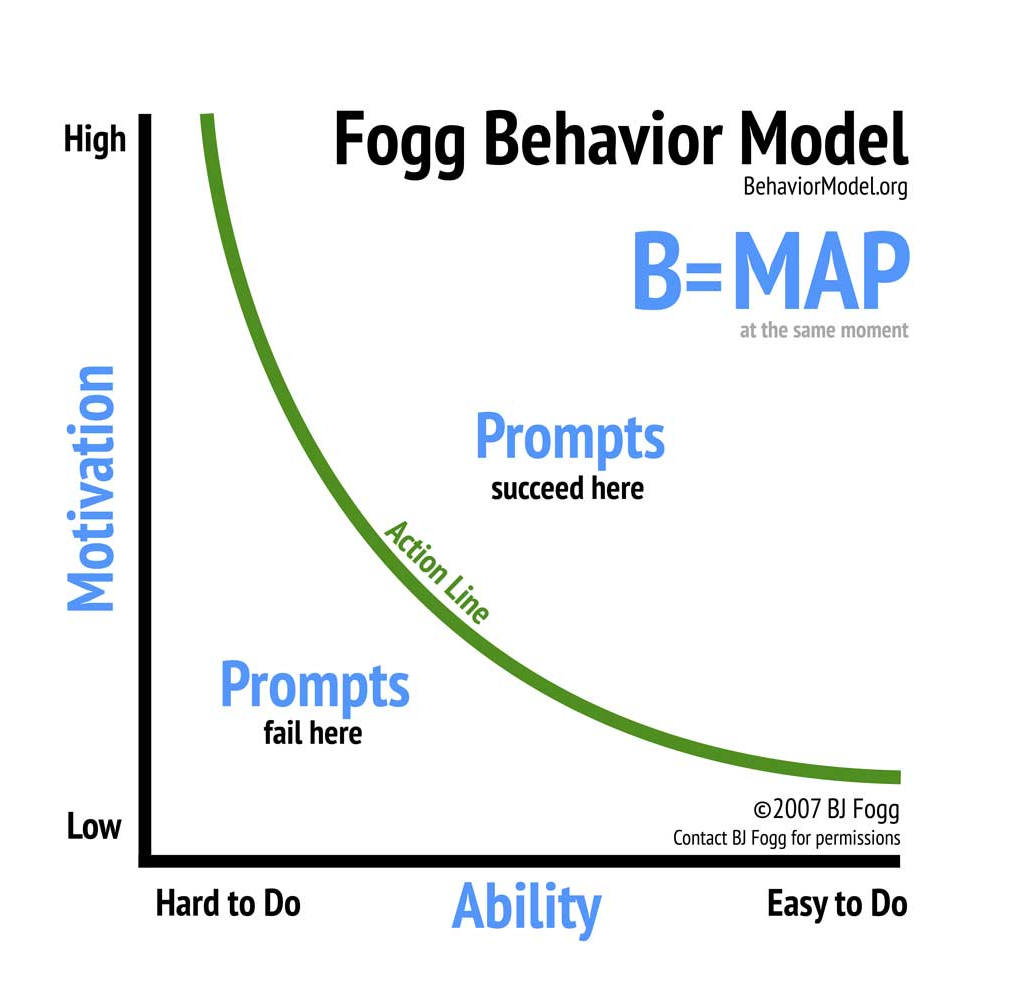In an era when behavioural change is a subject of keen interest for individuals and organizations alike, the BJ Fogg Behavior Model stands out as a particularly useful framework. Developed by BJ Fogg, a behaviour scientist from Stanford University, this model seeks to dissect the key elements that influence behaviour, thereby providing a roadmap for successful behavioural modification.

The Three Core Components: B = MAP
The Fogg Behavior Model is built around a simple formula: B = MAP. According to Fogg, any given behaviour (B) is a product of three key elements converging at the same moment:
- Motivation (M) – The individual has to be motivated to perform the behaviour.
- Ability (A) – The individual must possess the ability to carry out the behaviour.
- Prompts (P) – A trigger or cue must be present to initiate the behaviour.
Motivation
Motivation can vary along a spectrum, from high to low. Fogg points out that people are more likely to perform a behavior when they are highly motivated. Motivational factors can range from social approval to fear to monetary rewards. However, motivation alone is insufficient to bring about behaviour change.
Ability
Ability refers to the ease with which a person can perform a behaviour. A behaviour is more likely to occur if it’s easy to do. This aspect encourages designers of behaviour change interventions to simplify tasks, thereby increasing the likelihood of the behaviour taking place.
Prompts
Prompts, formerly called “triggers,” are cues that signal it’s time for the behaviour to happen. These could be environmental, like a notification on your smartphone, or emotional, like feeling stressed leading you to eat a chocolate bar.
Implementing the Fogg Behavior Model
Understanding the model is one thing, but implementing it in real life is where the real challenge lies. Here are some ways you can implement the Fogg Behavior Model:
Personal Development
- Tiny Habits: If you want to build a new habit, make it extremely easy to do (Ability), find a strong motivational factor (Motivation), and set a clear prompt (like setting an alarm).
- Monitoring: Use tracking tools to gauge your motivation levels and adjust your plans as needed.
Corporate Setting
- Employee Training: Instead of overwhelming employees with a load of information, break down the training into bite-sized modules, which increases the ease (Ability), and send reminders or prompts.
- Motivational Talks and Rewards: Enhance motivation by involving motivational speakers or setting up a rewards system.
Making Tasks Clear
The first step in effective mentoring is making tasks clear. A well-defined task serves as a guiding star that provides direction and purpose. A task’s clarity ensures that the employee knows exactly what is expected, how to measure success, and what the desired outcome should be. Ambiguity is the enemy of productivity; it leads to confusion, wasted effort, and demotivation. Therefore, clarity is not just a best practice but a necessity for success.
How to Make Tasks Clear
- Explicit Instructions: Avoid vague directions and provide detailed guidelines.
- Context: Explain how the task fits into the larger project or organizational goals.
- Metrics: Define clear metrics to measure performance and outcome.
Simplicity Based on Personality
Every employee is different, and a one-size-fits-all approach is rarely effective. Some people are motivated by challenges, while others may find them daunting. The mentor’s role is to understand the employee’s personality, skills, and interests and to tailor tasks accordingly.
Tailoring to Employee Personality
- The Problem-Solver: Give them tasks that require analytical thinking but ensure it’s not so complicated that it becomes paralyzing.
- The Social Butterfly: Assign team-based tasks or projects that require communication.
- The Creative Mind: Offer tasks that allow for creative expression but within manageable scopes.
Simpler Tasks and Motivation
Drawing upon the Fogg Behavior Model’s concept of ‘Ability,’ simpler tasks are easier to accomplish and therefore, require less motivation. The lower the complexity of a task, the less mental and emotional effort is needed to initiate and complete it. When an employee finds a task simple, it becomes easier to set triggers or prompts for them to perform the required behaviour.
Reducing Effort
- Break it Down: If a task is complex, break it into smaller sub-tasks.
- Checkpoints: Provide regular intervals for feedback to make course corrections, if needed.
- Resource Allocation: Ensure employees have the tools and resources needed to complete the task effortlessly.
Conclusion
The BJ Fogg Behavior Model provides an invaluable framework for understanding and effecting behaviour change. It has been applied across various domains to deliver impact. The beauty of this model lies in its simplicity and the actionable steps it suggests for making lasting behavioural changes. Whether you are an individual aiming for personal development or an organization looking to enhance productivity, this model offers effective strategies for achieving your goals.

Add a Comment